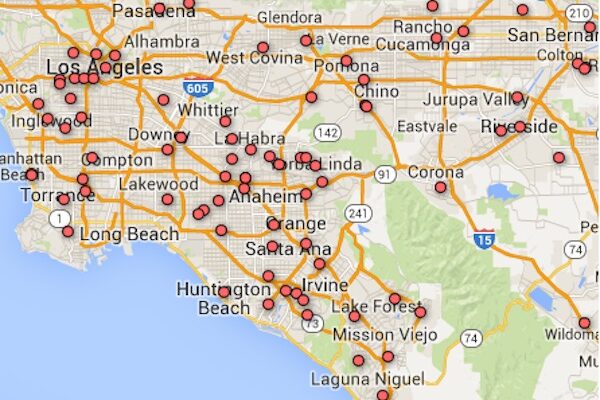Megachurches
Adapted from the description provided by the Hartford Institute for Religion Research.
When researchers talk about “megachurches,” they are generally referring to any Protestant congregation with a sustained average weekly attendance of 2,000 persons or more in its worship services. There are nearly 1,600 megachurches in the United States, in addition to many more located throughout the world. Attendance at U.S. megachurches averages almost 4,000 people, with the largest, Joel Osteen’s Lakewood Church in Houston, Texas, averaging approximately 45,000 people attending services each week. The largest megachurches however are located abroad, with the Yoido Full Gospel Church in Seoul, Korea averaging 240,000 in weekly attendance (480,000 including satellite campuses.) In California, there are 191 megachurches, comprising a total attendance of about 765,000 each week. The largest megachurch in the state is Saddleback Community Church in Lake Forest, with over 22,000 regularly attending weekly worship services.
Interactive Map of California Megachurches:
[iframe height=”600″ src=”https://www.google.com/fusiontables/embedviz?viz=MAP&q=select+col12+from+1RqEk9bKyFcRwUKPsbKaBvBupCu8AX7uoYOAoAXM&h=false&lat=36.879621&lng=-118.828125&z=6&t=1&l=col12″]
While size is what most observers—whether researchers, journalists or attenders—note as the defining characteristic of these congregations, megachurches in the United States also share many other traits. For example, almost all megachurches have a conservative theology, even those within mainline denominations, and most identify as evangelical. Many are nondenominational churches but the majority are affiliated with a denomination, although often those who attend thse churches are unaware of their denominational affiliation. (Note that most people consider Rick Warren’s Saddleback Church to be nondenominational, but it is actually a member of the Southern Baptist denomination.)
Over seventy percent of megachurches are located in the southern Sunbelt of the United States, with Texas, Florida and Georgia, as well as California, having the highest concentrations. Further, most megachurches are located in suburban areas of rapidly growing sprawl cities such as Los Angeles, Dallas, Atlanta, Houston, Orlando, Phoenix and Seattle. As this suburban location might suggest, a significant number of megachurches occupy prominent land tracts of up to 100 acres that are near major highways and which include large parking lots to accommodate the large number of commuting worshipers. In fact, in some cases these parking lots are so large, the church utilizes a shuttle system to get worshipers from their cars to the sanctuary, and at the close of services, often need to employ local police for traffic control as the hundreds of cars exit the parking lots and enter the nearby roadways.
Megachurches also house many social, recreational, and outreach ministries. These, in addition to other intentional efforts, such as home fellowships and interest-based small groups, are intended to overcome the potential anonymity of the large congregation and to enhance the feeling of community belonging among members. Contrary to expectations, these congregations promote intense personal commitment in a majority of their members, but they also contain a large percentage of attenders who remain anonymous and removed from deeper participation in the congregation.
Megachurches tend to grow to their great size within a very short period of time, usually in less than ten years, and under the tenure of a single senior pastor. Nearly all megachurch pastors are male, and are viewed as having considerable personal charisma. The senior minister often has an authoritative style of preaching and administration and is nearly always the singular dominant leader of the church. Supporting these senior pastors are teams of 5 to 25 associate ministers, and often hundreds of full-time staff.
Few megachurches have been exceptionally large for longer than the tenure of their current minister. Evidence suggests, however, that these churches can remain vital following a shift in leadership from the founder to his successor. Although some researchers have argued that the megachurch era is coming to a close and that megachurches are in decline, the total number has actually increased from 350 in 1990, to the current 1,600 megachurches in the U.S. In sum, megachurches have shown an amazing ability to adapt to changing cultural tastes of their publics, always offering something that appeals to a broad swath of the Christian community.
Additional Resources:
For more data and resources on megachurches in North America, visit the Hartford Institute for Religion Research site, which includes a database of all megachurches in the U.S., research reports, and a bibliography of research on megachurches.
For a listing of megachurches around the globe, visit the Leadership Network for a sortable database of the world’s largest megachurches.
For an excellent description and analysis of the current state of megachurches, read the book Beyond Megachurch Myths by Scott Thumma and Dave Travis. Other notable books on megachurches are, Seeker Churches: Promoting Traditional Religion in a Nontraditional Way by Kimon Sargeant, The Megachurch and the Mainline: Remaking Religious Tradition in the Twenty-First Century by Stephen Ellingson, and Reinventing American Protestantism by Donald E. Miller.
For other views on megachurches read Sacred Subdivisions: The Postsuburban Transformation of American Evangelicalism by CRCC research associate Justin Wilford. This book is an in-depth study of Rick Warren’s Saddleback Community Church in Lake Forest, California. Another study that investigates the relationship between American culture and religion is Finding Faith: The Spiritual Quest of the Post-Boomer Generation by Richard Flory and Donald E. Miller. Chapter four analyzes the cultural ecology of megachurches, framing them as congregations that “appropriate” larger cultural trends into their church structure and ministry.






